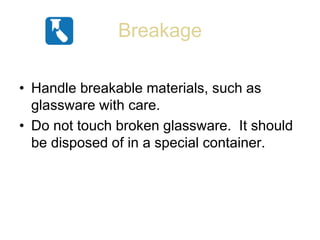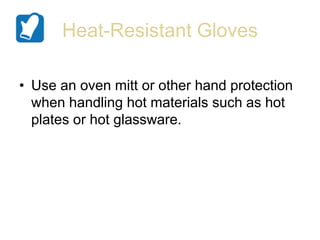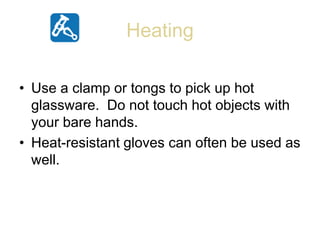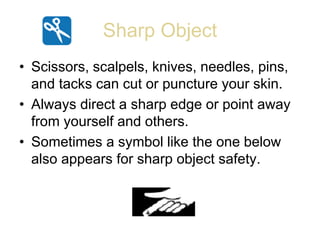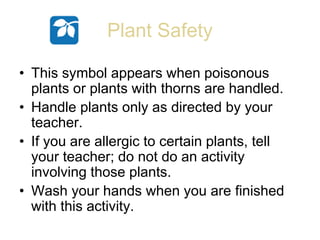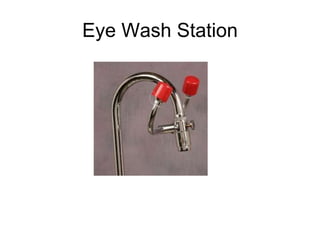Lab safety 01.pptx
- 3. Safety Goggles âĒ Wear safety goggles to protect your eyes in any activity involving chemicals, flames or heating, or glassware. âĒ Should something get into your eyes, notify your teacher if you are wearing contacts.
- 4. Lab Apron âĒ Wear a laboratory apron to protect your skin and clothing from damage, particularly when using chemicals.
- 5. Breakage âĒ Handle breakable materials, such as glassware with care. âĒ Do not touch broken glassware. It should be disposed of in a special container.
- 6. Heat-Resistant Gloves âĒ Use an oven mitt or other hand protection when handling hot materials such as hot plates or hot glassware.
- 7. Plastic Gloves âĒ Wear disposable plastic gloves when working with chemicals and organisms. âĒ This symbol often appears when you are going to handle harmful chemicals. âĒ Keep your hands away from your face, and dispose of the gloves according to your teacherâs instructions.
- 8. Heating âĒ Use a clamp or tongs to pick up hot glassware. Do not touch hot objects with your bare hands. âĒ Heat-resistant gloves can often be used as well.
- 9. Flames âĒ Before you work with flames, tie back loose hair and clothing. âĒ All materials should be kept at a distance. âĒ Follow instructions from your teacher about lighting and extinguishing flames.
- 10. No Flames âĒ When using flammable materials, make sure there are no flames, sparks, or other exposed heat sources present. âĒ The use of an open flame could cause a fire or explosion with certain materials.
- 11. Corrosive Chemical âĒ Avoid getting acid or other corrosive chemicals on your skin or clothing or in your eyes. âĒ Gloves should be worn for the activity. âĒ Do not inhale the vapors. âĒ Wash your hands thoroughly after the activity.
- 12. Poison âĒ Do not let any poisonous chemical come into contact with your skin, and do not inhale its vapors. âĒ Wash your hands thoroughly when you are finished with the activity.
- 13. Fumes âĒ Work in a ventilated area when harmful vapors may be involved. Avoid inhaling the vapors directly. âĒ Only test an odor when directed to do so by your teacher, and use the wafting motion to direct the vapor toward you nose.
- 14. Sharp Object âĒ Scissors, scalpels, knives, needles, pins, and tacks can cut or puncture your skin. âĒ Always direct a sharp edge or point away from yourself and others. âĒ Sometimes a symbol like the one below also appears for sharp object safety.
- 15. Animal Safety âĒ Treat live or preserved animals or animal parts with care to avoid harming the animals or yourself. âĒ Wash your hands when you are finished with the activity.
- 16. Plant Safety âĒ This symbol appears when poisonous plants or plants with thorns are handled. âĒ Handle plants only as directed by your teacher. âĒ If you are allergic to certain plants, tell your teacher; do not do an activity involving those plants. âĒ Wash your hands when you are finished with this activity.
- 17. Electric Shock âĒ To avoid electric shock, never use electrical equipment around water, or when the equipment is wet or your hands are wet. âĒ Be sure cords are untangled and cannot trip anyone. âĒ Unplug equipment not in use.
- 18. Physical Safety âĒ When an experiment involves physical activity, avoid injuring yourself or others. âĒ Alert your teacher if there is any reason you should not participate.
- 19. Disposal Safety âĒ Dispose of chemicals and other laboratory materials safely, as many cannot go down the sink drain. âĒ Follow the instructions from your teacher.
- 20. Hand Washing âĒ Wash your hands thoroughly when finished with the activity. âĒ Use antibacterial soap and warm water. Rinse well.
- 21. General Safety Awareness âĒ When this symbol appears, follow the instructions provided. âĒ When you are asked to develop your own procedure in a lab, have your teacher approve your plan before you go further.
- 22. Other Safety Symbols âĒ Radioactive Safety âĒ This symbol appears when radioactive materials are in use. âĒ Biological Safety âĒ This symbol appears when there is danger involving bacteria, fungi, or protists.
- 24. Fire Blanket
- 25. Eye Wash Station
- 26. First Aid Kit




